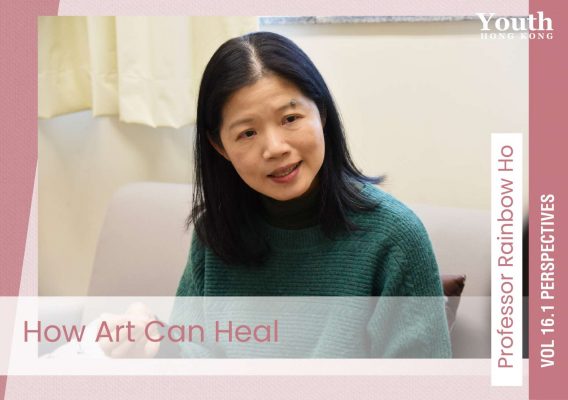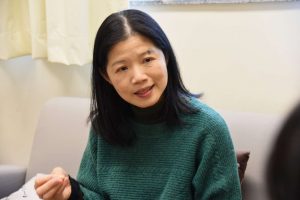//vol.16-1 Perspectives: Art Therapy
How Art Can Heal
An interview with Professor Rainbow Ho
Professor Rainbow Ho from Hong Kong University’s Expressive Arts Therapy programme spoke with us on the benefits of art therapy, as well as the magic of engaging in arts.
While trying to make art approachable to everyone, she aims to turn arts engagement into health behaviour and a new lifestyle.
Could you provide a brief overview of expressive arts therapy and explain how it functions in a therapeutic context?
Expressive arts therapy incorporates visual art, dance, movement, music, writing or poetry, and drama to help people deal with trauma, understand themselves, and achieve personal development.
The guiding principle of art therapy is to leverage the participant’s existing skills to engage them in a creative experience and the healing process. We believe the individual can discover and learn. Art allows them to express, observe, listen, move, and witness their thoughts and emotions. The creative process becomes a space where they confront challenges and address their problems. Our role as facilitators is to create time, space, and environment where individuals can creatively resolve their mental issues.
Art is powerful. Art helps people to understand and know more about themselves, other people and the world. It can bridge the conscious and unconscious, helping us to express or communicate things that we are unconscious of. Art is not a cognitive product. It is not about logic with linear thoughts.
What are the differences when we talk about art therapy and expressive arts therapy?
We have two types of art related therapy. Usually when we talk about art therapy, it refers to visual art therapy or one of the creative art therapies which uses a single modality like music, visual art, dance, music, drama, poetry. Expressive arts therapy is an integrative format that uses more than one art form.
Can you share some key findings or insights from your research?
I recently published a study on dance movement therapy for older adults with dementia. Participants in the dance therapy group experienced decreased depression and loneliness. This is crucial because loneliness is a significant issue for many older adults, especially after retirement and the loss of family members. The lack of social engagement often leads to chronic loneliness, which is a major risk factor to depression and, subsequently, suicide.
In our study, those who participated in dance movement therapy reported feeling happier and more connected to others. This intervention not only reduced loneliness but also positively impacted stress hormone levels. Similar positive outcomes were observed in other groups, such as stroke survivors, cancer patients and adults with intellectual disabilities.
Similar interventions using arts are also effective for young drug addicts. Participants reported enhanced social support, feeling more connected to others, and an improved sense of meaning in life. This aspect is particularly crucial for individuals who may have previously felt helpless or hopeless.
The concept of art therapy is not new and has been introduced to Hong Kong for decades. How did it first start in Hong Kong?
Art therapy has been present in Hong Kong for several years, but its growth has been gradual. Initially, only a handful of well-trained art therapists returned to Hong Kong after receiving their education to pioneer the field. The profession is still evolving, with a growing interest from individuals keen on using art as a means of helping those with mental illnesses.
The roots of art therapy trace back to the aftermath of World War II, where various forms of creative art therapy gained traction in psychiatric hospitals. This approach became increasingly appealing when traditional therapies, such as medication, showed limited breakthroughs. As a result, people in Hong Kong began exploring alternative methods like art therapy to address mental health challenges.
How effective is arts therapy? Are there any challenges or limitations?
Arts therapy stands out for being engaging, approachable, and effective in reducing social stigma. Participants often experience joy throughout the process, as arts therapy adopts a strength-based approach, focusing on individuals』 strengths rather than weaknesses. Joining an arts therapy group is also less stigmatised, considering that expressive therapy can be beneficial for both healthy individuals and those facing challenges. This inclusive aspect makes it a valuable avenue for people to engage in, especially during times of increased social isolation, like the COVID lockdowns.
However, a challenge lies in the cost associated with professional arts therapy, which is like seeking specialised medical help in Hong Kong. To make arts therapy more accessible, we are exploring community-based art projects in collaboration with NGOs and museums like Tai Kwun and M+. While this approach may not address severe psychological issues, it serves as a preventive measure, promoting mental well-being within the community.
What lessons can individuals learn from art therapy? How can we incorporate art into our daily lives to enhance our mental wellbeing?
I always mention the aesthetic experience. The word 「aesthetic」 originally came from a Greek word which means perceive, feel and sense. In ancient China, we have Six Arts practised by Confucians and music is one of them. Chinese arts were not solely for performance but served as a means for self-cultivation. Perhaps this is why the Guqin, a seven-string Chinese musical instrument produces low sound volume, as it is primarily intended for self-development and enjoyment.
My suggestion is to enhance your aesthetic appreciation and engage more in art making, be it photography, drawing, listening to music, dancing, or visiting art museums, where you can connect with others and yourself. This is what all of us can do in our daily lives.
Whether you are actively engaged in art-making or passively experiencing arts, strive to cultivate a sense of appreciation. Once you develop the ability to appreciate beauty, you have changed the way you live and how you see the world. Use the angle, use the perspective, so you feel everything differently. ■
“Once you develop the ability to appreciate beauty, you have changed the way you live and how you see the world.”
Rainbow Ho is a Professor of the Department of Social Work and Social Administration and director of the Master of Expressive Arts Therapy program at the University of Hong Kong. She is a registered and board-certified dance movement therapist and expressive arts therapist.




